NEWS RELEASE: Project Permitting on Track for Completion in 2012.
August 30, 2012: Montreal, Quebec – Stornoway Diamond Corp. (Stock Profile – TSX: SWY) announced the successful completion of public hearings on the Renard Diamond Project held by the Review Committee (“COMEX”) established under the James Bay and Northern Québec Agreement (the “JBNQA”). The COMEX hearings were held in Chibougamau and Mistissini on August 28th and 29th, and are expected to be the final round of public consultation prior to the determination of the project’s eligibility to receive its global Certificate of Authorization. The Certificate of Authorization is the principal regulatory approval needed to advance the project to the construction and mining stages, and is expected to be assessed prior to the end of the year.
The Renard Diamond Project falls under the environmental protection regimes of the JBNQA and the Canadian Environmental Assessment Act. The Renard Environmental and Social Impact Assessment (“ESIA”) was filed in December 2011 with the Canadian Environmental Assessment Agency and the Québec Ministère du Développement Durable, de l’Environnement et des Parcs. Public hearings on the ESIA, held separately by the federal and Québec regulators, are an important step in the mine permitting process, and are designed to gauge the overall social acceptability of the proposed development. As with the federal consultations held in June, attendance in both communities for the COMEX hearings was considerable, and comments received on the project were overwhelmingly positive.
To learn more – CLICK HERE.
CompanyFeed™
NEWS RELEASE.
August 29, 2012: Vancouver, BC – Balmoral Resources Ltd. (Stock Profile – TSXV:BAR & OTCQX:BALMF) reported today that exploration drilling on its Martiniere Property in Central Quebec, conducted well outside the previously known extent of the Martiniere Gold System, has intersected three new, broad areas of gold mineralization.
The new discoveries materially expand the scale and potential of the gold mineralized system on the Property. In addition to the three new gold discoveries, the Company also intersected a wide interval of anomalous zinc mineralization while testing a new VMS target on the Property. The Martiniere Property, centered approximately 45 kilometres east of the Detour Lake gold deposit, is centrally located within Balmoral’s 82 kilometre long Detour Trend Gold Project in Quebec, Canada.
The three new discoveries returned anomalous gold mineralization over down hole intervals of 82.00, 25.97 and 11.00 metres (see table below). The new discoveries are located 440 metres southwest, 1,200 metres west and 2,050 metres southwest of the Company’s recently announced bonanza grade gold discovery in hole MDE-12-29 which returned 273 g/t gold over 3.88 metres (August 16, 2012).
“Today’s discoveries, in three previously untested areas of the Martiniere Property, continue to demonstrate just how regionally extensive this gold bearing system is and the tremendous opportunity it represents for the Company,” said Darin Wagner, President and CEO of Balmoral Resources.
To view a table of the results – CLICK HERE.
CompanyFeed™

Analysts continued to speculate on the prospects for more quantitative easing from the US Federal Reserve. Heading into the weekend, spot market Dollar gold prices looked set for a gain of more than 3% on the week, after gold rallied following Wednesday’s publication of Fed policy meeting minutes.
Spot market gold bullion prices hovered just below $1670 an ounce for most of Friday morning’s London trading, a few Dollars below yesterday’s four-month high.
“Additional stimulus is inevitable, the question is how it comes,” reckons Charles Morris, who manages around $2.5 billion at HSBC Asset Management. “There’s no doubt about it, this is gold’s moment. All the long-term trend signals suggest that gold is in a very strong bull market.”
Going by the PM London gold fix, a fix of $1668 or higher this afternoon would make this gold’s biggest weekly gain since January.
Federal Open Market Committee minutes published Wednesday said that “many members” judge that more monetary stimulus, such as a third round of quantitative easing (QE3), could be needed “fairly soon” if economic data did not point to a recovery.
“If [August’s nonfarm payrolls report shows] another 150,000 or more jobs added, that buys them some time,” says Tom Porcelli, chief US economist at RBC Capital Markets, referring to the monthly report from the US Bureau of Labor Statistics showing the net addition of private sector jobs added by the economy.
“If it’s 100,000 or below,” adds Porcelli, “I think they will consider teeing up QE3 for September.”
August’s nonfarm payrolls report is due to be published September 7, with the FOMC meeting the following week.
The volume of gold bullion held to back shares in the SPDR Gold Trust (GLD), the world’s largest gold ETF, rose to its highest level since April yesterday at 1286.5 tonnes.
On the Shanghai Gold Exchange meantime, gold forward contracts hit their highest levels in nearly five months Friday, with trading volumes also rising.
Wholesale silver bullion prices meantime hovered above $30.30 per ounce Friday morning – nearly 8% up on the week – while other commodities were also flat on the day.
“In the short-term, it would be difficult to see considerably higher commodity prices without quantitative easing from central banks,” says Daniel Briesemann at Commerzbank.
“In the long term [though], I don’t think that commodities need quantitative easing measures, as they can rise without it. The economy should recover and demand in emerging markets is still relatively robust.”
Here in Europe, leaders must “stand by [their] obligations” according to a statement from German chancellor Angela Merkel, released following Thursday’s meeting with French president Francois Hollande to discuss Greece.
“We, and I, will encourage Greece to pursue the path of reform that demands a lot from the people,” said Merkel.
A day earlier, Eurozone finance chief Jean-Claude Juncker said it “would not be advisable to put further demands” on ordinary Greek people who “have suffered a lot”.
Greek prime minister Antonis Samaras is due in Berlin today for talks with Merkel, where he is expected to ask for additional time to implement austerity measures. Samaras then heads to Paris tomorrow to meet Hollande.
ECB president Mario Draghi said Friday that the central bank will wait until a preliminary ruling by Germany’s Constitutional Court before revealing any details of a bond buying plan. The Court is due to make a ruling on September 12 over whether creating the Eurozone’s permanent bailout fund violates German law.
In the U.S., the creation of a “gold commission” to examine the possibility of restoring the Dollar’s link to gold bullion is set to become official Republican party policy, the Financial Times reports.
“There is a growing recognition within the Republican party and in America more generally that we’re not going to be able to print our way to prosperity,” says American Principles Project chairman Sean Fieler.
A similar commission three decades ago recommended not returning to gold, with Ron Paul dissenting and writing the minority report, which was later published as ‘The Case for Gold‘.
NEWS RELEASE.
August 23, 2012: Vancouver, B.C. – MAG Silver Corp. (Stock Profile – TSX:MAG & NYSE MKT:MVG) announced a private placement offering of common shares at a per share price of C$9.40 (the “Offering”) for gross proceeds of approximately C$25 million. The common shares will be subject to a four month hold period. The Offering is expected to close on or about September 5, 2012.
The Company intends to use the net proceeds from the Offering to fund the recently announced permitting and underground development program for Juanicipio, advancement of Cinco de Mayo including continued exploration as well as generation of an initial resource estimate, and for general corporate purposes.
To read more – CLICK HERE.
CompanyFeed™
NEWS RELEASE.
August 20, 2012: Vancouver, BC – Balmoral Resources Ltd. (Stock Profile – TSXV:BAR & OTCQX:BALMF) has been advised by GTA Resources and Mining (Stock Profile – TSXV:GTA) that drilling has resumed on the Company’s Northshore Property located in the Hemlo-Schreiber greenstone belt of Ontario. The Phase 3 drilling program will consist of approximately 20 diamond drill holes totaling a minimum of 5,000 metres.
According to GTA, drilling will target further expansion of the Afric Gold Zone and high-grade Audney and Caly vein systems contained there-in. To date drilling by GTA has confirmed the presence of gold mineralization associated with the broad Afric Gold Zone for 280 metres in an east-west direction and to vertical depths in excess of 300 metres. The mineralized corridor remains open to the east, west, north and to depth.
“With the success of our exploration efforts and on-going drilling on the Martiniere Property in Quebec and resumption of drilling at Northshore, our shareholders should have a great deal to look forward to this fall,” said Darin Wagner, President and CEO of Balmoral.
To read more – CLICK HERE.
CompanyFeed™
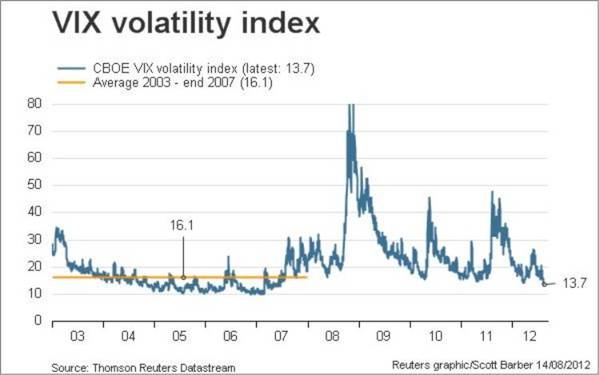
Stocks and interest rates are back to late spring – pre latest European fear levels – and the Jefferies/Thomson Reuters CRB commodities price index is at a three-month high.
Risk assets are obviously back in favor with investors – possible action by the European Central Bank (ECB) and the US Federal Reserve (Fed) could offer an explanation why:
- There is speculation Fed Chairman Ben Bernanke could signal another round of quantitative easing at the Jackson Hole, Wyo. end of August Fed meeting.
- ECB President Mario Draghi promised to defend the euro so markets are expecting a move from Europe’s central bank.
The CBOE Market Volatility Index, the VIX or “Fear Index” as it’s known recently hit its lowest level since the global credit crisis erupted five years ago.
Mike Dolan offers us an explanation of what the VIX is and questions why such high levels of investors complacency…
“Given almost biblical gloom about the world economy at the moment, you really have to do a double take looking at Wall Street’s so-called “Fear Index”. The VIX, which is essentially the cost of options on S&P500 equities, acts as a geiger counter for both U.S. and global financial markets.
Measuring implied volatility in the market, the index surges when the demand for options protection against sharp moves in stock prices is high and falls back when investors are sufficiently comfortable with prevailing trends to feel little need to hedge portfolios. In practice — at least over the past 10 years — high volatility typically means sharp market falls and so the VIX goes up when the market is falling and vice versa. And because it’s used in risk models the world over as a proxy for global financial risk, a rising ViX tends to shoo investors away from risky assets while a falling VIX pulls them in — feeding the metronomic risk on/risk off behaviour in world markets and, arguably, exaggerating dangerously pro-cyclical trading and investment strategies.
Well, can that picture of an anxiety-free investment world really be accurate? It’s easy to dismiss it and blame a thousand “technical factors” for its recent precipitous decline. On the other hand, it’s also easy to forget the performance of the underlying market has been remarkable too. Year-to-date gains on Wall St this year have been the second best since 1998. And while the U.S. and world economies hit another rough patch over the second quarter, the incoming U.S. economic data is far from universally poor and many economists see activity stabilising again.
But is all that enough for the lowest level of “fear” since the fateful August of 2007? The answer is likely rooted in another sort of “put” outside the options market — the policy “put”, essentially the implied insurance the Fed has offered investors by saying it will act again to print money and buy bonds in a third round of quantitative easing (QE3) if the economy or financial market conditions deteriorate sharply again.” Mike Dolan, Put Down and Fed Up, blogs.reuters.com.
There is no doubt in this author’s mind most people believe the world’s governments and central banks will step in with some form of quantitative easing. Current market conditions are clearly showing this. If Draghi and Bernanke come through, commodities would seem like a good place to have my money.
NEWS RELEASE.
August 16, 2012: Vancouver, BC – Balmoral Resources Ltd. (Stock Profile – TSXV:BAR & OTCQX:BALMF) reported today that the first of the ME-series holes completed as part of the summer drill program on its Martiniere Property has discovered a new bonanza grade, gold bearing structure in the footwall to the Bug Lake Gold Zone. The Footwall discovery returned, on an uncut basis, 272.39 g/t (8.0 oz/ton) gold over 3.88 metres (12.7 feet) across the width of the mineralized structure. Included in this interval are adjacent bonanza grade intercepts of 1,530 g/t (44.6 oz/ton) gold over 0.55 metres (1.8 feet) and 409 g/t gold (11.9 oz/ton) over 0.50 metres (1.6 feet). The Martiniere Property, located approximately 45 kilometres east of the Detour Lake gold deposit, is centrally located within Balmoral’s 82 kilometre long Detour Trend Gold Project in Quebec, Canada.
“With two more shallow gold discoveries, including the broad Bug Lake Zone and our highest grade intercepts to date, the scale and potential of the gold system at Martiniere continues to rapidly expand,” said Darin Wagner, President and CEO of Balmoral. “The presence of multiple high-grade zones of gold mineralization, which we have thus far intersected across 1,500 metres at Martiniere, is the principal hallmark of all of the large gold systems in the Abitibi region of Ontario and Quebec. These systems commonly host a number of individual gold deposits reaching to vertical depths of over 1,000 metres. Historically it has been extremely rare for one Company to control the entirety of a given system like Balmoral appears to at Martiniere. With the vast majority of our drill testing to date above the 150 to 200 metre vertical level, and the system remaining open in all directions, the potential for new discoveries and further growth of the Martiniere gold system is excellent.”
To review the drill results – CLICK HERE.
CompanyFeed™
NEWS RELEASE.
August 15, 2012: Vancouver, B.C. – MAG Silver Corp. (Stock Profile – TSX:MAG & NYSE MKT:MVG) announced the board of directors of Minera Juanicipio S.A. de C.V., (owned 44% by MAG / 56% by Fresnillo plc), has approved a mine permitting and underground development budget of US$25 million. The 18 month (2012 -2013) budget includes the first 2,500 metres of underground development. The Joint Venture has begun the permitting process and anticipates receipt of all necessary permits by the end of 2012. The underground decline ground breaking is expected in early January 2013 (Q1) pending receipt of all permits.
“We are very pleased to be working with our Joint Venture partner, Fresnillo, in realizing the underground development recommendations from our recently completed Updated Preliminary Economic Assessment (“UPEA”). The Joint Venture Board has now put the project on the priority fast track towards breaking ground in very early 2013,” said Dan MacInnis, President and CEO of MAG Silver. “The UPEA confirms that Juanicipio is an extraordinary silver deposit with such robust economic margins that moving into an underground development stage is the next logical step.”
To read more – CLICK HERE.
CompanyFeed™
PRESS RELEASE.
August 14, 2012: Mother nature seems to be blind to political boundaries, despite what previous data would suggest in the preparation of Canada’s next major gold mine at Detour Lake within the prolific Abitibi Gold Belt. But as Detour Gold (Stock Profile – TSX:DGC) nears construction completion on its mine on the Ontario side of the belt, the management team of Balmoral Resources (Stock Profile – TSXV:BAR) immediately on the Quebec side of the provincial border seek to defy the concept that the system contains almost 30 million gold ounces on one side of the border, and nothing on the Quebec side.
With one of the largest land positions in the Abitibi, Balmoral now controls over 82 kilometres of the Sunday/Detour Lake deformation zone, all within the friendly confines of the province of Quebec. Compared to Ontario, which offers little in terms of perks, Quebec is practically rolling out the red carpet for any company that’s willing to invest in the province’s mining industry.
Balmoral has nestled itself in a favourable position, capitalizing on “closeology” with respect to Detour Lake, and raising eyebrows from potential takeover suitors along the way. This is management’s follow-up foray after successfully converting its last project West Timmins into a deal valued at $424 million through a sale to Lake Shore Gold [LSG:CA] in 2009, following the discovery of the high-grade Thunder Creek deposit in Timmins, Ontario.
To read more CLICK HERE.
CompanyFeed™
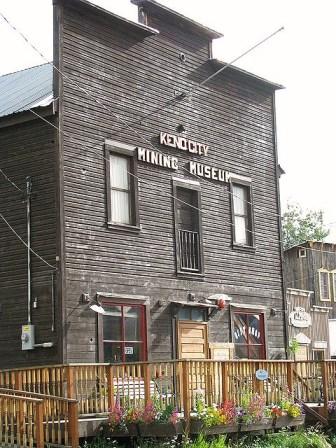
Famous for the Klondike Gold Rush, the Yukon Territory is a barren land with 35,000 inhabitants. Located in Canada’s deep north, the Yukon yields an annual three to five month exploration window for mining companies. With summer coming to an end, drill results are pending and many miners are hoping to find the Yukon’s next big discovery.
Once a mine is established operations are not limited to just a few months a year. Rather, production continues despite the cold weather. The Yukon holds the record for the coldest temperature ever in North America. On February 3, 1947, a temperature of minus 63 degrees Celsius was recorded at Snag, Yukon.
Despite the weather, the Yukon is the 10th most attractive jurisdiction for mineral exploration and development in the world and the first Canadian territory to ever reach the top 10 according to the annual Fraser Institute Survey of Mining Companies 2011/2012. In part because the Yukon government is very mining proactive through the Yukon Chamber of Mines.
The Yukon also has great geology and hosts significant deposits of gold, copper, lead, zinc, silver, tungsten, coal and iron. A little known fact is that one of North America’s largest iron ore deposits is in northeastern Yukon: the total resource of the deposit is estimated to be in excess of eighteen billion tons of 46% Fe iron ore.
Mineral exploration in the Yukon has a long history of discoveries starting with the Klondike Gold Rush in 1897. The initial Klondike stampede was triggered by the arrival of over US$1,139,000 (equivalent to US $1 trillion today) in gold at northwestern American ports in July, 1897.
Newspaper reports of the gold and the success of the miners fuelled a nation-wide hysteria. Between 1897 and 1899 an estimated 100,000 people travelled to the Klondike region of the Yukon with the hopes of striking it rich.
Although the Yukon is famous for its Klondike Gold Rush, the Keno Hill silver deposit, discovered in 1918, actually produced more pay-dirt than the Klondike.
This lesser known but very rich precious metals district made the Yukon one of the world’s leading silver producers for decades – the Keno Hill District reportedly produced more than 217 million ounces of silver between 1921 and 1988.
Alexco Resource (Stock Profile – TSX:AXR & NYSE-MKT:AXU), with operations in Keno Hill, began production from their Bellekeno silver mine in 2011. Alexco’s work in Yukon is unique in that it includes advanced exploration, environmental care and maintenance for deposits mined in the past, and reclamation planning for past producing mines.
For Yukon Mining Districts – Part 2: CLICK HERE.
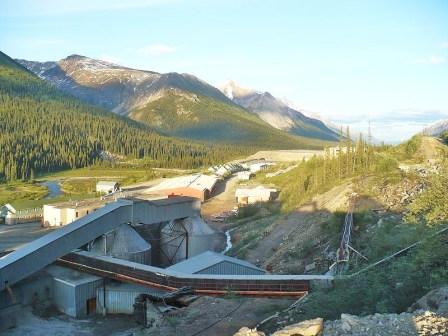
The latest Yukon discoveries to fuel rushes include the Selwyn Basin in 1953, the Finlayson Lake District in 1994 and the White Gold District in 2009.
Located in eastern Yukon, the Selwyn Basin is one of the world’s largest underdeveloped lead-zinc districts. The Faro deposit, discovered in 1965, contained a combined pre-mining mineral resource of 120 million tonnes grading 5.6 percent zinc, 3.7 percent lead and 45 to 50 grams/tonne silver. The Tom and Jason deposits owned by Hudbay Minerals (Stock Profile – TSX:HBM & NYSE:HBM) mark two of the district’s more recent discoveries.
Along the border of the Northwest Territories in the Selwyn Basin, you will also find North American Tungsten’s (Stock Profile – TSXV:NTC) Mactung deposit. Just across the border is the company’s Cantung mine. These two deposits are estimated to contain about 15 percent of the world’s known economic tungsten reserves.
Significant volcanogenic massive sulphide deposits are found in the Finlayson Lake District. The Kudz Ze Kayah deposit was discovered in 1994 (11.3 million tonnes of 5.9 percent zinc, 1.5 percent lead, 0.9 percent copper, 1.37 grams/tonne silver, 1.3 grams/tonne gold) and in 1995 the Wolverine deposit (3.75 million tonnes of 12.5 percent zinc, 1.4 percent lead, 1.4 percent copper, 336.6 grams/tonne silver, 1.6 grams/tonne gold) was discovered.
In 2009, a significant gold discovery was made by TSXV-listed Underworld Resources when they announced 3.39 g/t Au over 104.0 meters. These impressive numbers ultimately resulted in Kinross Gold (Stock Profile – NYSE:KGC & TSX:K) acquiring Underworld Resources for $139.2 million and the birth of the White Gold District. The district is located in the Yukon’s Dawson Range where a number of promising juniors are exploring including ATAC Resources (Stock Profile – TSXV:ATC), Ethos Gold (Stock Profile – TSXV:ECC) and Comstock Metals (Stock Profile – TSXV: CSL).
The successful start-up of the Minto copper-gold mine by Capstone Mining (Stock Profile – TSX:CS & OTCPK:CSFFF) in the Yukon has given the territory a good reputation. In the case of Minto, Yukon’s processes were seen to be transparent and efficient with timely processing of permit applications. This demonstrated to many industry participants that the Yukon is a good place to develop a mine.
Capstone recently released a Phase VI Pre-feasibility Study extending the mine life to 2022 with an average of 40 million pounds of copper production per year. According to Capstone’s CEO, Darren Pylot: “The Minto Mine has been very successful as the Yukon’s first operating hard rock mine since the 1990’s. It started operations in 2007 at 1,600 tonnes per day with an eight year mine life, and now, five years later, as a result of successful exploration this latest study and development plan extends the mine life to 2022 at a proposed production rate of 3,750 tonnes per day”.
Currently, Minto’s production rate is 3,600 tonnes per day. Concentrates from the Minto mine are exported via the Port of Skagway, Alaska, to smelters in Asia for treatment and sale.
For Yukon Mining Districts – Part 1: CLICK HERE.

What do Doug Belanger, President of embattled mining company Gold Reserve and Arnold Schwarzenegger have in common? The are both lead performers in Judgement Day. For Schwarzenegger, Judgement Day was the name of the second film in the Terminator franchise. For Belanger, Judgement Day is the ongoing saga associated with the Brisas deposit in Venezuela.
A clip from Terminator 2 pretty much sums up the Brisas story. Picture teen actor Edward Furlong as Hugo Chávez and Belanger as Schwarzenegger: CLICK HERE.
MiningFeeds featured Gold Reserve (Stock Profile – AMEX:GRZ & TSX-V:GRZ) in the August, 2011 article, “Gold Reserve Makes $2.1 Billion Claim Against Venezuela”. For the backstory – CLICK HERE. In its claim (using US$950 per ounce gold) Gold Reserve valued its damages at $2.1 billion, equivalent to over $30 a share. Gold Reserve’s shares are currently trading at $3.40, up a $1 per share over the past year.
The oral hearings were concluded on February 17, 2012 in Washington, D.C. and the company has since filed two additional post hearing briefs and is in the process of filing a third at the request of the tribunal. The tribunal consists of three judges who are actively working on the case.
The Venezuelan government is currently battling about 20 post-nationalization arbitration cases and has previously settled a number of ICSID claims against it including, most recently in March, 2012 with Williams Companies and Exterran for the 2009 nationalization of assets including a major gas injection project.
Prior to a judgement by the World Bank ICSID tribunal, Venezuela reached an agreement of $420 million with the companies. Williams and Exterran were seeking $1.2 billion in damages.
According to VenezuelaAnalysis.com, Hugo Chávez expressed his desire to “get out” of the ICSID. Chávez states, “The verdicts of the ICSID do not respect national laws or jurisprudence, neither can they be appealed. The ICSID makes decisions on a whim without a unifying system of jurisprudence. The ICSID systematically favours the transnationals.”
Withdrawal from ICSID does not offer any immediate benefits to Venezuela. These pending cases are in no way affected by Venezuela’s denunciation of the ICSID Convention.
However, it may be Chávez himself that “gets out”. Venezuelan national elections are set for October 7th, 2012 and this time, Chávez has some real competition in Henrique Capriles. Capriles’s youth, energy, and record of competent governance in Venezuelan’s state of Miranda make him a credible challenger to Chávez particularly when factoring in Chávez recent health issues. Capriles has been critical of Chávez’s nationalization policies.
There are other issues at hand which may encourage Venezuela to settle with Gold Reserve. Namely, the estimated $230 million the company invested in engineering, metallurgical, and drilling data. The company is sitting on full feasibility reports for Brisas that would take between 5 and 7 years to reproduce.
With judgement day likely “months” away, Gold Reserve is in regular communication with the defendants in the case. According to Gold Reserve’s president, Doug Belanger, “We are now communicating with Venezuela’s newly formed Ministry of Oil and Mines. The new ministry is headed by Rafael Ramirez, who is also president of the Petróleos de Venezuela, S.A. (PDVSA), one of the world’s largest oil companies. Ramirez is probably the second most powerful person in Venezuela. Although we believe in the merits of our case we are not opposed to a settlement should one be deemed acceptable by our board.”
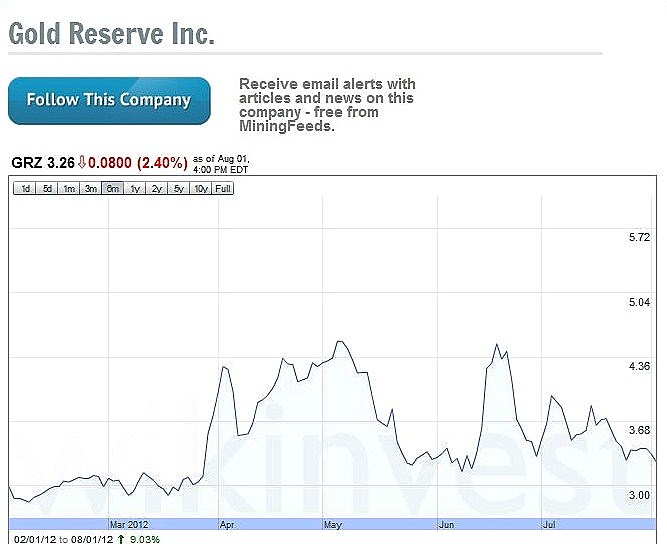
As an investor in mining stocks it is difficult to stay connected with your investments and the companies on your watch list. Wouldn’t it be great if someone designed an email application that sent you daily updates featuring company-specific news and media articles?
Well, it is great and it’s a free service from MiningFeeds.com.
On each Stock Profile page on MiningFeeds.com there is a “Follow This Company” button that allows you to receive company-specific email alerts with articles and news. Sign into MiningFeeds.com on the top right side of the website using one of your social accounts (Facebook, Twitter, Google or Yahoo) and then select the companies you want to follow.
Please note: our social sign in tool is completely confidential (we do not have access to your password) and we take your privacy very seriously – review our Privacy Policy.
Once you’re logged in, you can add or remove companies from your follow list at any time. You can also access your “Settings” on MiningFeeds.com which includes a list of all the companies you follow. Based on your follow list, our system automatically emails you daily news and articles on the companies that matter to you.
The complexities of technology and internet development are endless. When I asked a developer at MiningFeeds what he thought was the most incredible invention of all time I was surprised by his response. He answered the thermos. Hearing his response I asked, “Why the thermos”. His reply, “When I put in hot coffee it stays hot. When I put in cold lemonade it stays cold. How does it know the difference?”
“Follow This Company” knows the difference between the companies you are interested in and the ones you are not. A free service from MiningFeeds and yet another reason why MiningFeeds.com is the internet’s #1 financial website focusing on the mining sector.
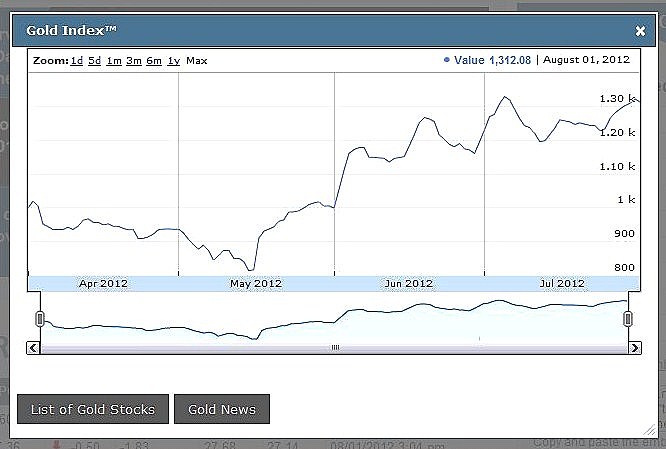
At MiningFeeds, we are committed to providing mining investors with the best information available on the internet. But we are not just fans of mining, we are also fans of technology. In April, 2012 we launched our unique and proprietary “Mining Stock Indexes”.
These indexes are connected to the category listings on MiningFeeds.com (gold, base metals, tech metals, etc.) and are calculated based on the price movements of the stocks listed in our respective stock lists.
The stock indexes were released on April 1st, 2012 and each mining stock index was set at 1,000. So how have mining stocks performed over the past four months? Easy, just look at our stock indexes and do the math:
- Gold Index: + 31.2%
- Silver Index: +27.2%
- Diamonds Index: +11.6%
- Base Metals Index: +3.4 (excluding copper stocks)
- Coal Index: – 2.6%
- Potash Index: – 6.5% (includes phosphate stocks)
- Copper Index: – 9.8%
- Uranium Index: – 12.9 %
- Tech Metals Index: – 23.5% (includes rare earth, lithium, cobalt, etc. stocks)
The stock indexes are calculated using the weighted average market cap of the stocks listed in each category. We also apply a $10 million market cap limit for a company to be included in the index calculation.
Using our Gold Stock List as an example, throughout the day our automated index system calculates the percentage change of hundreds of international gold stocks and gives you the live percentage change. Today, the Gold Stock Index is down 0.17%.
We have also added a built in charting feature so you can track daily/weekly/monthly price movements. Just click on “Gold Index” to access the price chart for the gold stock index on the Mining Stock Indexes widget.
As mentioned at the beginning, we are fans of technology. We’ve designed the Mining Stock Index as shareware – you will see a link that says “Embed Code” below the indexes.
If you click on the “Embed Code” link you will gain access to java script code that will allow you to embed the Stock Indexes directly into your website for free (similar to a YouTube video). The widget can be stylized to match the look and feel of your site.
Yet another feature that makes MiningFeeds.com the #1 financial website focusing on the mining sector.
If you would like to receive our free newsletter via email, simply enter your email address below & click subscribe.
CONNECT WITH US
Tweets
Tweet with hash tag #miningfeeds or @miningfeeds and your tweets will be displayed across this site.
MOST ACTIVE MINING STOCKS
Daily Gainers
 Lincoln Minerals Limited Lincoln Minerals Limited |
LML.AX | +125.00% |
      |
GCR.AX | +33.33% |
      |
CASA.V | +30.00% |
      |
AHN.AX | +22.22% |
      |
ADD.AX | +22.22% |
      |
AZM.V | +21.98% |
      |
NSE.V | +21.05% |
      |
DYG.V | +18.42% |
      |
AAZ.V | +18.18% |
      |
GLA.AX | +17.65% |

 Follow us on Twitter
Follow us on Twitter Become our facebook fan
Become our facebook fan








